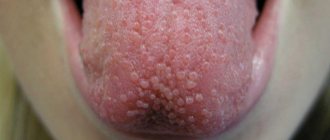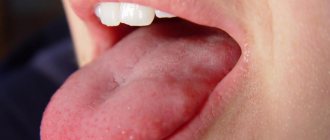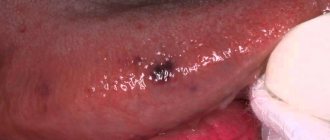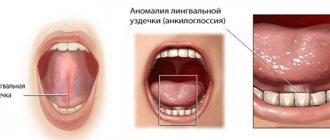It happens that unpleasant inflammations appear on the tongue, causing discomfort and pain. This happens often; almost every person has encountered this phenomenon at least once in their life.
Typically, the papillae on the tongue become inflamed due to external factors, and are characterized by their transience. But it happens that such a reaction of the tongue mucosa is provoked by internal factors, and is a symptom of a serious disease.
This article will tell you how to figure out what problem the patient is dealing with and help the tongue papillae return to normal as quickly as possible.
Causes of inflammation of the papillae on the tongue
Conventionally, the reasons that caused inflammation of the papillae of the tongue can be divided into 2 groups:
- The mucous membrane of the tongue can be damaged by gastric juice
mechanical (obtained as a result of mechanical action on the tissues of the tongue);
- internal (when inflammation of the receptors occurred as a result of diseases caused by pathogenic microorganisms and their metabolic products).
Mechanical reasons include:
- burns from chemical compounds (acids, alkalis, alcohols);
- burns from thermal effects (excessively hot food or drinks);
- the mucous membrane is damaged by gastric juice (most often this occurs during vomiting or reflux esophagitis, when gastric juice with food particles is thrown into the esophagus; gastric juice has a very acidic environment, which causes a chemical burn);
- mechanical damage from direct contact with an irritating object (for example, when sucking candy or from constantly eating food with a rough surface);
- household injuries, including damage to tongue tissue from hygiene items or accidental biting;
- when brushing your teeth aggressively: the bristles of the toothbrush injure the mucous membrane of the tongue;
- regular injuries resulting from sharp chipped teeth, unsuccessfully placed dentures or fillings;
- too spicy or salty food;
- stress and depression as factors that weaken the body's immune system.
Other reasons include:
- Language structure
diseases localized in the oral cavity (and caused by fungi, various bacteria and some types of viruses, including the herpes virus);
- allergies;
- uncontrolled or very long-term use of antibiotics;
- such systemic diseases as: scarlet fever, measles, diphtheria, anemia, disruptions in the gastrointestinal tract;
- avitaminosis;
- decreased immunity.
Important! It is necessary to distinguish between such types of inflammation of the papillae as papillitis and glossitis.
Papillitis occurs as a consequence of mechanical damage, and glossitis - as a consequence of pathogenic processes.
Why do the papillae sometimes become inflamed and enlarged?
Hypertrophy of the taste buds of the tongue often occurs in children and unbalanced people. The first ones to put dirty toys and hands into their mouths cause infection. The latter may bite their nails or stationery, from the surface of which pathogenic bacteria enter the mouth.
Inflammation of the white fungiform papillae of the tongue is provoked by viruses, bacteria, fungal infections, and systemic diseases. In this case, quite unpleasant symptoms are felt: burning and loss of taste, sensation of a foreign body on the tongue, pain when eating, talking, brushing teeth. READ ALSO: for what reasons can inflammation on the side of the tongue occur and how to eliminate it?
The cause of red spots is often irritation of the circumvallate papillae. They can become inflamed due to chemical and thermal burns of the oral cavity, gastroesophageal reflux disease. People with dentures and lovers of hard sweets and lollipops also complain about this problem. Inflammation cannot be avoided in the presence of chipped teeth that injure the mucous membrane of the tongue.
READ ALSO: tongue diseases with descriptions and photos
Symptoms
The patient may experience discomfort in communication due to impaired diction and thickening of the upper layer of the epithelium of the tongue
The main symptoms of inflammation of the papillae on the tongue are their redness (hyperemia) and soreness (or itching).
There are also disruptions in the perception of the taste qualities of food and drinks and their temperature conditions.
As a result of inflammation, the patient may experience discomfort in communication due to impaired diction and thickening of the upper layer of the epithelium of the tongue.
You can distinguish papillitis from glossitis by looking at the back of the tongue: if there is no plaque on it, this means the inflammation is non-infectious.
Also, the symptoms of papillitis tend to disappear within a few days without medical assistance, since a feature of the mucous membrane of the tongue is its rapid recovery.
Sometimes an infection is associated with papillitis, but this is considered a complication and goes into the category of glossitis.
External manifestations
If you look closely at the painful area, the inflamed papillae can be easily identified. They increase in size and change color, becoming soft pink, deep red or completely white (with candidiasis).
Thread-like stretched along the edges of the tongue. Their number is greatest, their function is to touch and hold food in the mouth, they do not perceive taste
General treatment recommendations and consequences
The formation of small blisters or ulcers, the appearance of white or pink papillae on the tongue, the proliferation of villi are the first symptoms of the inflammatory process, which can subsequently lead to hypertrophy of the grooved, mushroom-shaped and other types of papillae.
The dangerous consequences of glossitis are suppuration and the spread of infection to the respiratory and digestive organs. The pain that accompanies the enlargement of receptor structures interferes with talking and eating, and in children it causes severe anxiety and even weight loss. Therefore, any symptoms of glossitis require immediate treatment. The treatment tactics for inflammation of the tongue papillae depend on the cause of its development.
Treatment of tongue papillae inflamed due to injuries and burns
Burns and traumatic injuries to the mucous membrane of the tongue lead to the development of papillitis. In the absence of other alarming symptoms - fever, severe swelling and suppuration of tissues - papillitis can be dealt with at home. Carrying out at home:
- Rinsing the mouth with disinfectants. It is better to take decoctions of medicinal herbs, for example, calendula.
- Treating the tongue with agents that accelerate healing and restoration of soft tissues. Solcoseryl ointment, Lugol's solution, Chlorophyllipt, and sea buckthorn oil can be used.
- Use of analgesics: Lidocaine, Anestezin. It is better to consult your doctor about the dosage and regimen of taking painkillers.
During the treatment of inflammation of the taste buds of the tongue, you need to adhere to a special regime that allows you to create gentle conditions for soft tissues damaged by papillitis:
- It is undesirable to smoke and drink alcohol.
- You should not eat food with a strong salty or spicy taste.
- Temporary removal of removable dentures may be necessary.
If the cause of inflammation of the tongue papillae is a prosthesis, you should definitely consult a dentist to correct the shape or completely replace the uncomfortable design.
Treatment of infectious inflammation
In case of inflammation of the oral mucosa, glossitis and papillitis, you must adhere to the following rules:
- If the papillae on the root and edges of the tongue are enlarged, you should not drink alcohol-containing drinks, and it is not advisable to smoke.
- Food should be moderately salty, without hot spices, not hot and not very cold.
- If the cause of the appearance of red papillae on the tongue is an infection or disease of an internal organ, or the patient’s temperature rises, you should definitely go to the doctor to find out why the inflammation has developed. Such inflammatory processes pose the greatest danger to children, so you should contact a pediatrician immediately.
Papillitis and glossitis are serious diseases that not only cause discomfort, but also entail other dangerous consequences. If a person notices that his papillae on the tip or back of his tongue have enlarged, he should immediately consult a doctor in order to identify and treat the disease at an early stage. Mild forms of glossitis can lead to the development of more severe ones, accompanied by complete death of enlarged papillae and the risk of poisoning the body with microorganism toxins .
Localization
An important role in making a diagnosis and finding out the cause of the disease is its localization. The localizations of inflammation of the papillae, as well as the possible causes of their appearance, will be listed below.
In all languages
Inflammation of the papillae throughout the tongue may indicate a chemical or thermal burn, as well as the infectious nature of the disease.
Inflammation of the papillae throughout the tongue may indicate a chemical or thermal burn
On the root
If the problem area is the back of the tongue (root), then the patient will experience difficulty perceiving the bitter taste, since the inflammation will affect the grooved papillae responsible for this.
A popular cause of this localization of inflammation is an allergic reaction, with the patient noting increased salivation and swelling of the tissues, including the soft palate that may react with swelling.
The cause may be diseases associated with the gastrointestinal tract, or malfunctions in its functioning (for example, too low or high acidity). Also, it is on the root that fungal and bacterial glossitis is localized.
The cause may be diseases associated with the gastrointestinal tract or malfunctions in its functioning.
On the tip
The tip of the tongue most often suffers from mechanical damage, since the tip comes into contact with too hot food and drinks, rubs against chipped teeth, and is subjected to biting.
The tip of the tongue most often suffers from mechanical damage, since the tip comes into contact with food and drinks that are too hot
Side
On the sides of the tongue there are the so-called conical, mushroom-, filament- and leaf-like structures of the tongue.
Enlargement and hyperemia of the taste buds, which are located on the sides of the tongue, most often appear due to mechanical damage to the teeth, but pathogenic microorganisms and chemical burns can also be the cause.
Inflammation on the sides of the tongue can also be caused by pathogenic microorganisms and chemical burns.
Anatomy of the tongue with photos
The tongue is formed by striated muscle tissue covered with a mucous membrane. It is involved in digestion, speech formation, allows you to express emotions, sense tastes, and regulates salivation. In a healthy person, the tongue has a pale pink color, with an even hollow running along it. Normally, it is covered with a whitish coating, which allows the grooved papillae of the tongue to be clearly visible.
Anatomically, the tongue consists of a root (1/3) and a body (2/3), separated by a terminal groove, as can be seen in the photo. The part facing the sky is called the back. On the lower surface there is a frenulum attached to the floor of the mouth. The tongue moves freely in the oral cavity and is rarely at rest. Thanks to the muscles, it can rise, shorten and thicken.
INTERESTING: photo of the root of a person’s tongue and the reasons for its color change
Diagnostics
If the patient has inflamed papillae on the tongue and the symptoms do not go away within a day or two, if the symptoms worsen, if they are pronounced, and the points of inflammation themselves are very painful, then you need to consult a dentist.
The dentist will conduct an examination on the following points:
- If the presumptive diagnosis is associated with diseases of the internal organs, then additional consultation with other specialists will be required.
assess the color, shape and size of problem areas;
- determine whether there is swelling;
- check the tongue for mechanical tissue damage;
- examine the surface of the tongue for plaque; if it is detected, it will evaluate its location, color and quantity;
- check the tongue for the presence of ulcers or eczema;
- Assess the condition of the oral cavity as a whole.
The following tests may be required to make a diagnosis:
- Smear for histology;
- Tongue sensitivity testing;
- Blood sampling for general analysis and biochemistry;
- Blood test to exclude HIV, AIDS, hepatitis virus, syphilis and other pathogenic elements.
If the presumptive diagnosis is associated with diseases of the internal organs, then additional consultation with other specialists (gastroenterologist, dermatologist, endocrinologist, immunologist, ENT) will be required.
Prevention
Glossitis is easier to prevent than to treat. In order to avoid this unpleasant disease you need to follow simple rules.
The first is oral hygiene. This principle applies to both children and adults. If you wash your hands before eating, brush your teeth regularly, do not use someone else’s toothbrushes, and regularly sanitize your mouth, then the risk of developing tongue inflammation is minimal.
Try to avoid damaging the mucous membrane. Avoid eating hard foods that can damage your tongue, such as chips. Hot foods also cause epithelial defects. Spicy foods have an irritating effect. Abuse of them significantly worsens the condition of the tongue mucosa and increases the risk of infection.
Nicotine not only irritates the mucous membrane, but also impairs microcirculation, which reduces the resistance of the epithelium to the effects of infectious agents. Inflammatory diseases of the oral cavity are more common in smokers than in patients who are not adherents of this addiction. Strong alcoholic drinks also have a negative effect on the mucous membranes.
If you have symptoms of glossitis, do not self-medicate, contact a dental clinic. A competent specialist will determine the cause of the disease and prescribe treatment that will help quickly get rid of unpleasant symptoms. Remember, if glossitis is not treated, the disease can lead to serious complications and irreversible consequences.
Treatment
If after a couple of days the symptoms have not disappeared or, on the contrary, have intensified, rush to the dentist
If the papillae are inflamed, but the cause is difficult to determine, then first of all, rinse your mouth with an antiseptic solution.
If after a couple of days the symptoms do not disappear or, on the contrary, intensify, rush to the dentist.
After conducting the diagnostics, he will make a diagnosis and either refer you to another doctor or describe how to treat the problem.
Typically, treatment consists of antiviral (acyclavir, Zovirax) and antihistamine (suprastin, tavegil) drugs, antibiotics (clorsacillin, clindomycin) and antifungal agents (chlorhexidine, furacelin, miramistin).
If you can’t see a doctor, you can improve your condition at home.
The following methods are effectively used for this:
- You can apply ice (or chew it) to relieve swelling.
- Regularly rinse your mouth with a baking soda solution (15 grams of baking soda per 1 glass of lukewarm water) - this will help relieve inflammation and reduce swelling.
- Lubricate the problem area with honey - this product is famous for its antibacterial properties, and it will also help relieve swelling and promote tissue regeneration.
- Drink natural yogurt - it will help restore normal oral microflora if the problem lies in its disturbances.
Purpose and functions of language
The tongue takes part in several important processes occurring in the human body, and some diseases can be identified by its condition. Based on research, experts have found that the purpose of the human language is to perform the following functions:
- Digestive - takes part in the process of primary food processing (mechanical). The organ is responsible for proper salivation.
- Articulation – thanks to its structure, it becomes possible to speak,
- Absorption - mucous membranes have high permeability, which allows various substances to better penetrate the human body,
- Gustatory - thanks to this function we feel taste.
Features of child treatment
Even with papillitis, you can catch a serious complication
If a child complains of pain in the tongue, and you notice redness of the papillae, brush the baby’s teeth, ask him to rinse his mouth thoroughly, and go to the dentist.
The child’s immune system is not yet strong enough to cope with inflammation on its own.
Even with papillitis, you can catch a serious complication, since a curious child explores most objects from the surrounding world using the oral cavity.
What does plaque on the back and root of the tongue indicate?
The location and color of plaque can provide information about health problems. Using the diagram of its location, you can clarify the diagnosis. If a plaque is detected upon examination of the tongue, it acts as one of the first signs of weakened immunity. This is a common symptom of stomatitis in a child. If the appearance of plaque is associated with pathology, then even after removal with a toothbrush, it soon appears again. Examples of plaque formation on the tongue are in the photograph for the article:
- plaque at the root means inflammation of the intestines,
- plaque completely covers the back of the tongue toxins in the stomach or intestines,
- light red coloration of the tip and edges with a coating on the middle part of the back of the tongue - a violation of the acid-forming function of the stomach,
- sticky gray plaque with a pungent taste combined with bad breath – chronic gastroenteritis (acute gastroenteritis is indicated by a metallic taste in the mouth and a thin layer of whitish plaque),
- a thick layer of white plaque over the entire surface of the back of the organ – gastrointestinal pathology (including ulcers, gastritis, food intoxication and appendicitis).
( 1 ratings, average: 5.00 out of 5)
Form
Swollen, thickened tongue or curled sides. Problems with the liver and digestive system.
Subtle tongue. Problems with metabolism and circulatory system.
Long tongue (often red) or enlarged tip. Perhaps the heart is not in order.
Uneven longitudinal stripe in the middle. Problems with the spine.
Enlarged (swelling) at the edges. Problems with the stomach, intestines.
The bulge between the middle and the tip. Lung diseases.
The relief has been changed in places. Lack of B vitamins.
How to get rid of papillomas?
If the growths on your tongue are present in small quantities and are small in size, then the process of removing such growths is quite simple. But this does not mean that you can remove the papilloma yourself, using such “effective folk remedies” as cauterization, cutting the “leg” of the tumor with scissors, etc. To remove the growth, you should contact a professional medical institution.
Methods for removing tumors:
- Excision of papillomas with a scalpel or electric knife. This affects not only the growth itself along with the stem, but also part of the healthy tissue around it.
- Laser removal of tumors.
- By using a tool such as a conchotome, shaped like a wire cutter. After removing the papilloma with such a device, galvanoacoustics is performed (cauterization of the localization of the growth using a platinum wire).
Plaque color
It may differ from the color of the tongue itself. The thicker the plaque, the more serious the problem. Normally, a thin white coating is acceptable, which can be easily removed with a toothbrush or tongue brush.
White, thick coating . Intoxication, infectious disease.
Brown. Lung diseases.
Yellow. Disruption of the digestive system.
Grey. Gastritis, peptic ulcer.
Too smooth (polished) tongue . Lack of folic acid, riboflavin.










